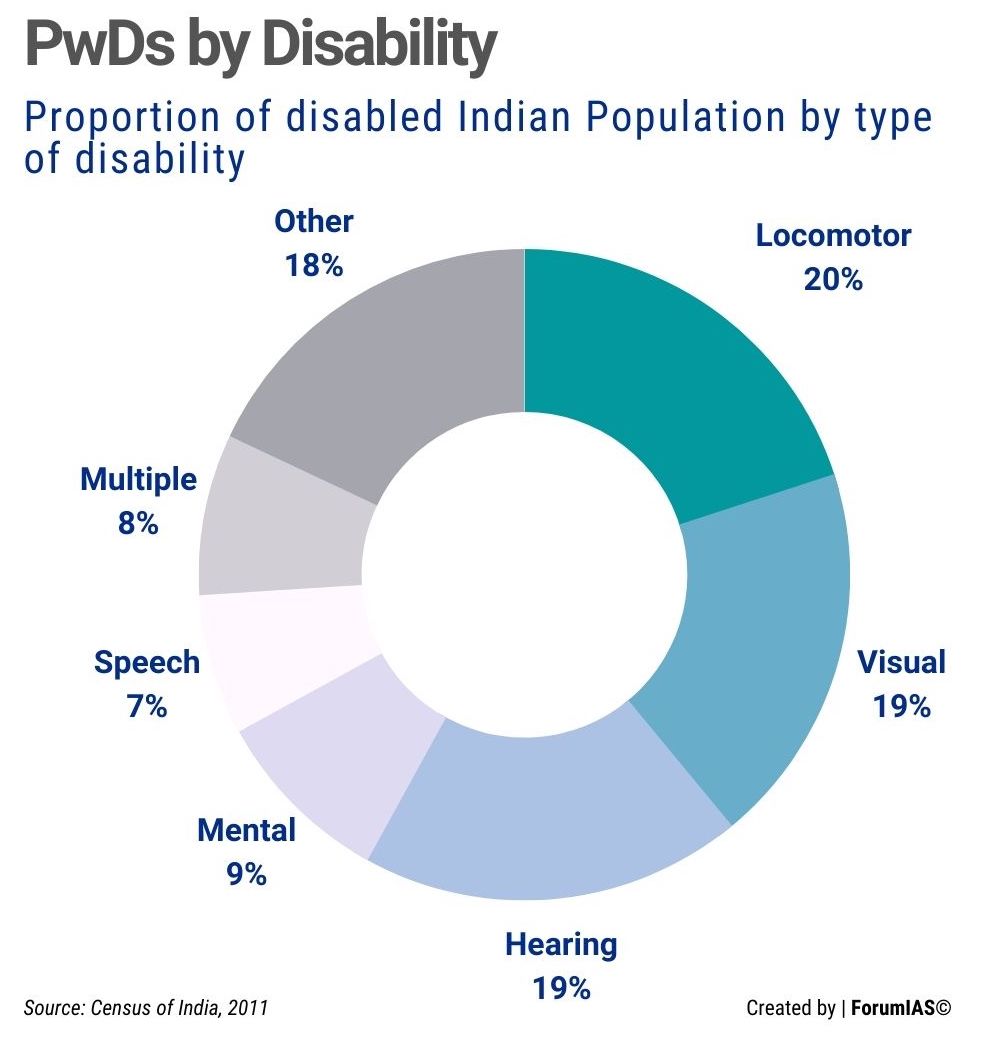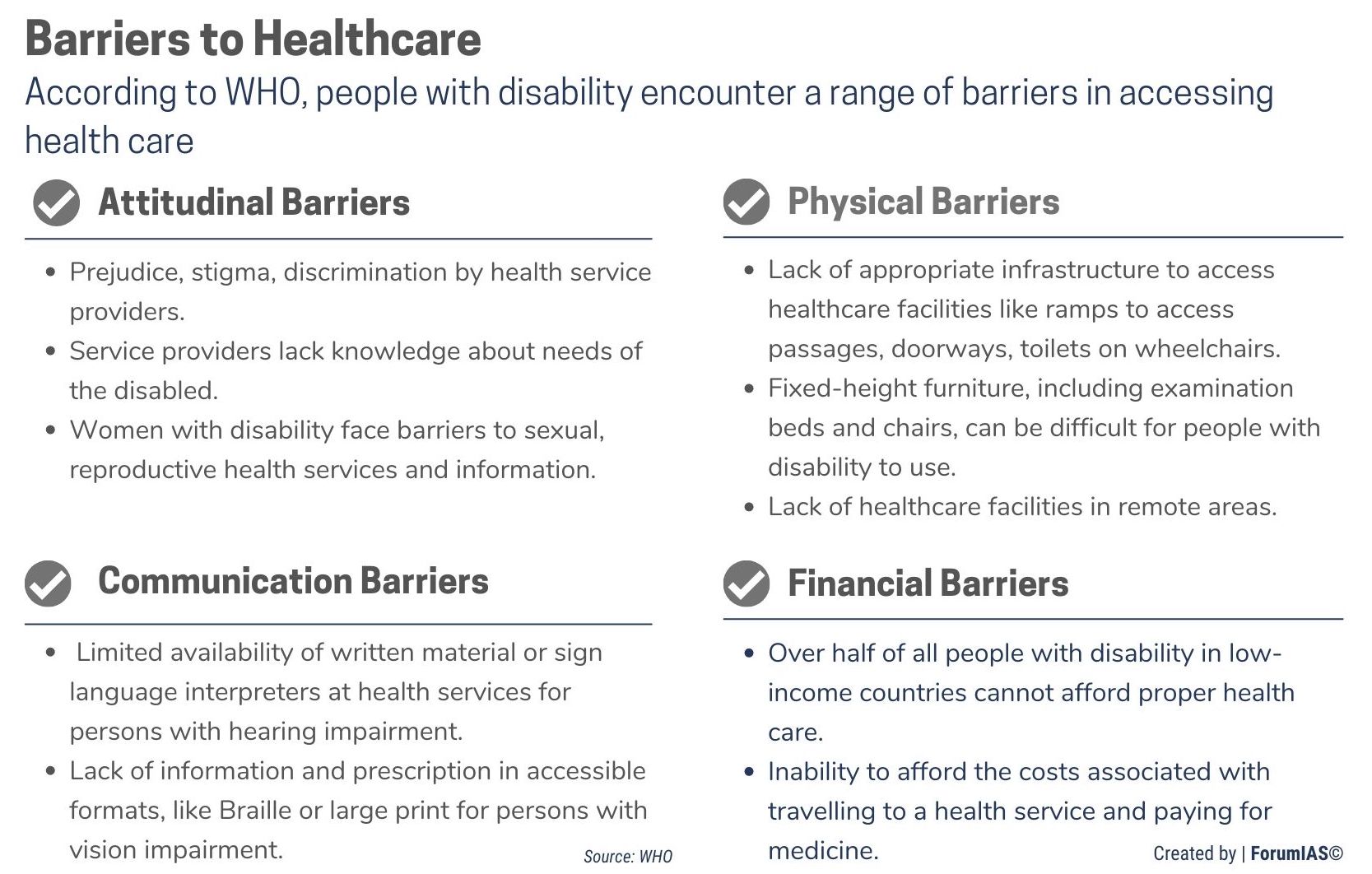ForumIAS announcing GS Foundation Program for UPSC CSE 2025-26 from 19 April. Click Here for more information.
Contents
- 1 Introduction
- 2 Who are the Persons with Disabilities?
- 3 What is the current status regarding Persons with Disabilities?
- 4 What provisions have been made for the Persons with Disabilities in India?
- 5 What are the challenges faced by Persons with Disabilities?
- 6 What should be done going ahead?
- 7 Conclusion
| For 7PM Editorial Archives click HERE → |
Introduction
In a recent Judgment related to compensation for a person rendered disabled by an accident, the Supreme Case made certain remarks regarding disability and persons with disabilities. The Court said, “…in the era of competition, the appellant cannot compete with ‘normal men’…”. The Court also noted that, “a person must be physically fit…to complete professional commitments”. The SC remarks are facing criticism from disability rights activists as being out of touch with the current thinking on disability rights. There have been lot of progressive developments regarding rights of persons with disabilities. Yet they continue to face considerable challenges including social apathy.
Who are the Persons with Disabilities?
The United Nations Convention on the Rights of Persons with Disabilities (UN CRPD) defines “Persons with disabilities include those who have long-term physical, mental, intellectual or sensory impairments which in interaction with various barriers may hinder their full and effective participation in society on an equal basis with others“.
The World Report on Disability 2011 sums up the various definitions of disability by stating that “Disability is complex, dynamic, multidimensional, and contested“.
The Rights of Persons with Disabilities Act, 2016, uses the same definition as the UN CRPD. It further defines “Person with Benchmark Disability” as “A person with not less than 40% of a specified disability”.
The 2016 Act had expanded the types of disabilities from 7 (under the Person with Disabilities (Equal Opportunities, Protection of Rights and Full Participation) Act, 1995) to 21. Further, the Union Government will have the power to add more types of disabilities.
What is the current status regarding Persons with Disabilities?
In India, there were around 26.8 million persons with disabilities, constituting 2.21% of India’s total population (2011 Census).
There were 14.9 million men (2.41% of men) and 11.9 million women (2.01% of women) with disabilities. 69% (18 million) of persons with disabilities reside in rural areas.
20% of persons with disabilities in India have a disability in movement, 19% have visual impairment, 19% have a hearing impairment and 8% have multiple disabilities.
Disabilities are highest in the age group 10-19 years (46.2 lakh people).
At an all India level, 34% of the total disabled population is reported as ‘workers’. The proportion is highest in Nagaland (~52%) followed by Sikkim (49%) and Arunachal Pradesh (~45%).
The Disability rights activists and academicians working on disability issues, however, say that these numbers in the census are a very small percentage of the actual numbers. World Bank data on the total number of persons with disabilities in India suggests the number is between 40 and 80 million.
What provisions have been made for the Persons with Disabilities in India?
Constitutional Provisions
Preamble: The Preamble seeks to secure social (as also economic and political) justice to all citizens along with equality of status and of opportunity.
Fundamental Rights: Dignity of the individual is the fundamental notion behind all the fundamental rights guaranteed under the Constitution. All fundamental rights are available to the persons with disabilities.
Directive Principles: Article 41 exhorts the State to make effective provisions for securing the right to work, education and to public assistance in case of unemployment, old age, sickness and disability.
According to Article 46, State shall promote educational and economic interests of the weaker sections of the people and protect them social injustice and all forms of exploitation.
Relief of the Disabled is a State Subject (Entry 9 in List II) under the Seventh Schedule.
Welfare of the Disabled and mentally retarded is listed as item 26 in the Eleventh Schedule and item 09 in the Twelfth Schedule.
Legal Provisions
The Mental Health Act, 2017: It replaced the Mental Health Act, 1987. It has been passed with the objective to provide for mental healthcare and related services for persons with mental illness and to protect, promote and fulfill their rights.
The Rights of Persons with Disabilities (RPwD) Act, 2016: It came into force in April 2017. It replaced the Persons with Disabilities (Equal Opportunities, Protection of Rights and Full Participation) Act, 1995. It fulfils the obligations to the United National Convention on the Rights of Persons with Disabilities (UNCRPD). The Act has several provisions for benefit of persons with disabilities like it has increased the magnitude of reservation for Persons with Disabilities from 3% to 4% in government jobs and from 3% to 5% in higher education institutes. It stresses to ensure accessibility in public buildings in a prescribed time frame.
The Rehabilitation Council of India Act, 1992: It provided statutory status to the Rehabilitation Council of India (RCI, established in 1986). The mandate given to RCI is to regulate and monitor services given to persons with disability, to standardise syllabi and to maintain a Central Rehabilitation Register of all qualified professionals and personnel working in the field of Rehabilitation and Special Education.
The National Trust for the Welfare of Persons with Autism, Cerebral Palsy, Mental Retardation and Multiple Disabilities Act, 1999: It has been enacted with the objective to provide for the constitution of a body at the National level for the Welfare of Persons with Autism, Cerebral Palsy, Mental Retardation and Multiple Disabilities. The trust aims to provide total care to persons with mental retardation and cerebral palsy and also manage the properties bequeathed to the Trust. The Trust strives to enable persons with disability to live independently by: (a) Promoting measures for their protection in case of death of their parents; (b) Evolving procedures for appointment of their guardians and trustees; (c) Facilitating equal opportunities in society.
Welfare Programmes
Accessible India Campaign: It aims for creation of Accessible Environment for PwDs. It was launched in December 2015. The campaign is based on the principles of the Social Model of Disability, which means disability is caused by the way society is organised and not by the person’s limitations and impairments. The aim of the Campaign is to make a barrier free and conducive environment for Persons with Disabilities all over the country. The campaign targets three separate verticals for achieving universal accessibility (a) Built up environment; (b) Transportation ecosystem; (c) Information & Communication Technology (ICT) ecosystem.
Deendayal Disabled Rehabilitation Scheme (DDRS) aims to create an enabling environment to ensure equal opportunities, equity, social justice and empowerment of persons with disabilities. Under DDRS, NGOs are provided with financial assistance for running their projects for the rehabilitation of persons with disability. Projects include Special school, pre-school and early intervention, Halfway Homes and Community Based Rehabilitation etc.
Assistance to Disabled Persons for Purchase/Fitting of Aids and Appliances (ADIP): Its aim is to assist the needy disabled persons in procuring durable and scientifically manufactured appliances. It helps promote their physical, social, and psychological rehabilitation by reducing the effects of disabilities and enhancing their economic potential. It is implementated by NGOs, National Institutes under the Ministry of Social Justice & Empowerment, and ALIMCO (a PSU that manufactures artificial limbs).
| Read More: Access to Assistive Technology: Challenges and Solutions – Explained, pointwise |
Indian Sign Language Research and Training Centre: It promotes the use of sign language and also to develop human resources in the field.
National Institute of Mental Health Rehabilitation (NIMHR): It aims to work towards capacity building in the field of mental health rehabilitation. It also aims to develop community-based rehabilitation protocols for mainstreaming persons with mental illness who have been successfully cured.
What are the challenges faced by Persons with Disabilities?
Social Challenges: (a) Discrimination and Inequality: They face several types of discrimination e.g., often there is reluctance to hire PwDs for employment; (b) Loss of Social Status: Lack of opportunities results in lack of employment, money etc.; (c) Inhuman Treatment: People suffering from mental illness or mental retardation are subject to social exclusion; (d) Loss of Identity: The identity of PwDs becomes linked with their disability and become a subject of pity.
Access to Education: Persons with visual impairment lack education materials for their studies. Children with learning disabilities are shunned and not admitted to schools. There is lack of special schools and trained teachers for children with learning disabilities.
Unemployment: They have lower employment rates. Private sector is reluctant to hire PwDs due to stereotypes and stigma. It impacts their ability to be financially independent and be self-sufficient.
Accessibility: Lack of appropriate disabled-friendly physical infrastructure creates accessibility issues e.g., PwDs find it difficult to commute in public transportation, or access buildings.
Improper Execution of Policies: Disability inclusion efforts are hampered by poor execution of policies and programmes.
What should be done going ahead?
Accommodation and Inclusion: There is a need to identify opportunities to better accommodate people with disabilities in Society – like providing better education, equal opportunity in job, and initiating them to take active part in social and political decision.
Sensitisation: Overcoming stigma is necessary in order to facilitate better integration of Persons with Disabilities into the mainstream. The Prime Minister coined the term “Divyangjan” to address persons with disabilities. The rationale is to change the social attitude towards them and recognise their potential. This attitude should be widely adopted. People need to be educated and be sensitized about the challenges faced by PwDs.
Preventive Measures: The Comprehensive Newborn Screening (CNS) programme under the Rashtriya Bal Swasthya Karyakram has been launched for early detection and prevention of disabilities. Under this, a comprehensive clinical examination is to be performed on all babies, usually within the first 48 hours of life. It must be scaled up in all States.
Interventions in Public Policy: A larger portion of the budget should be allocated to the welfare of disabled people. There ought to be budgeting for people with disabilities in line with the gender budget. It is important to make sure that plans are carried out correctly. There ought to be appropriate systems for the monitoring, as well as accountability, of public monies.
Conclusion
The Government has undertaken commendable initiatives for the welfare of the disabled and make them independent. However, they still face social exclusion driven by stigma and stereotypes about disability. There is a need to integrate Government’s effort with initiatives towards bringing a social change. Simultaneously Government should focus on better implementation of its initiatives. Indian Paralympic Athletes won 19 medals including 5 Gold medals in the Tokyo 2020 Paralympics which shows that with proper support, they can excel in any field. With social change and Government support, they can be mainstreamed into the society and their potential can be utilized in all fields of human endeavour.
Syllabus: GS II, Welfare schemes for vulnerable sections of the population by the Centre and States and the performance of these schemes; Mechanisms, laws, institutions and Bodies constituted for the protection and betterment of these vulnerable sections.
Source: Indian Express, NSO, Vikaspedia







